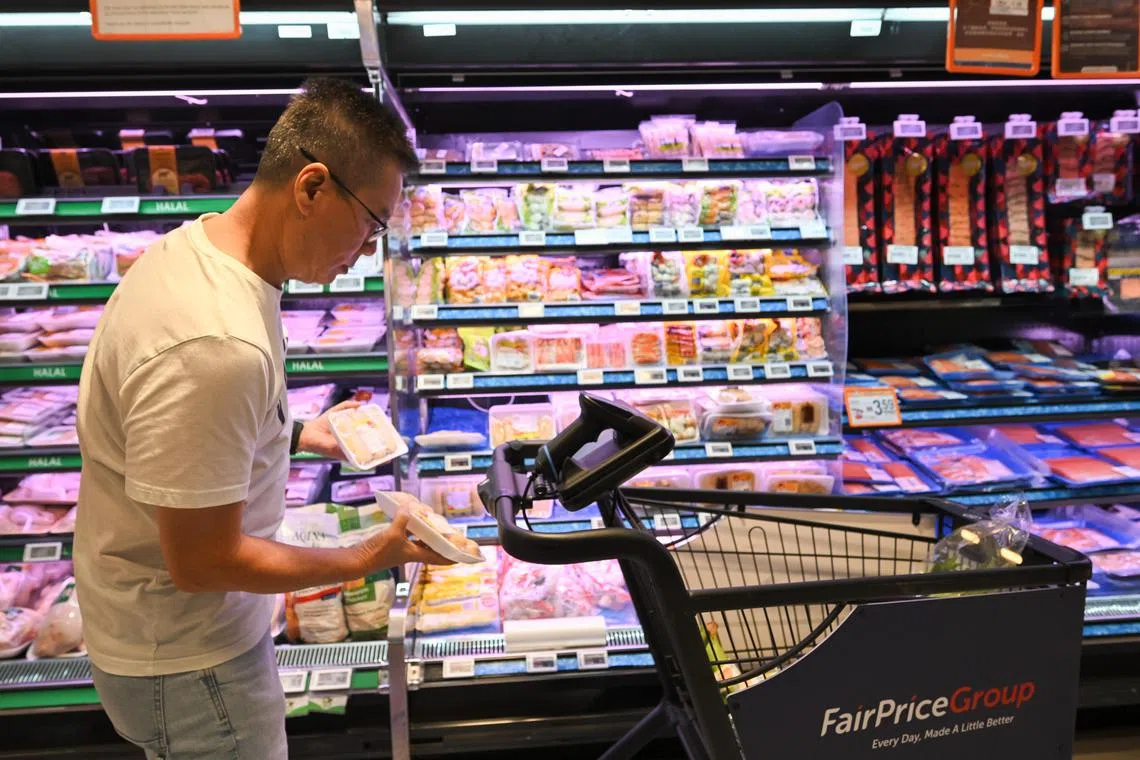Singapore’s core inflation stays unchanged in June but uncertainties to outlook remain high
Sign up now: Get ST's newsletters delivered to your inbox

Retail and other goods inflation registered zero per cent after falling 1 per cent in May and 1.2 per cent in April.
PHOTO: ST FILE
Follow topic:
- Singapore's core inflation remained at 0.6% year on year in June, unchanged from May, with month-on-month prices falling 0.1% (MAS & MTI).
- Higher retail and private transport costs were offset by lower inflation in food, accommodation, and services; electricity and gas prices also declined.
- MAS and MTI maintain a 0.5% to 1.5% inflation forecast for 2025, but "uncertainties to inflation remain high" due to global risks.
AI generated
SINGAPORE – Core inflation was unchanged in June with pricier retail and other goods offset by lower costs in categories such as food and services.
Core inflation, which excludes private transport and accommodation to better reflect household expenses, rose 0.6 per cent over June 2024, the same level as May.
It marks a slight dip from the 0.7 per cent level recorded in April, which was up on the four-year low of 0.5 per cent in March, noted the Monetary Authority of Singapore (MAS) and Ministry of Trade and Industry (MTI) on July 23.
Most economists believe the MAS will not ease monetary policy on July 30, despite the low inflation numbers.
Overall – or headline – inflation came in at 0.8 per cent in June, also unchanged from May, as higher private transport expenses were offset by a smaller increase in accommodation costs.
Both the core and overall inflation readings were lower than forecasts from economists in a Bloomberg poll.
Two categories registered higher inflation in June – retail and other goods, and private transport.
Retail and other goods inflation registered zero per cent after falling 1 per cent in May and 1.2 per cent in April. This was mainly due to pricier clothing and footwear.
Private transport costs rose 2 per cent year on year, after a 1.1 per cent increase in May and a 1.3 per cent rise in April. The increase was fuelled by a steeper rise in car prices and a slower pace of decline in the cost of petrol.
Other categories either registered lower prices or a slower pace of price rises.
Electricity and gas costs fell 3.9 per cent year on year in June, following a 3.7 per cent decline in May.
Food inflation eased to 1 per cent in June from 1.1 per cent in May.
Similarly, a smaller increase in rents meant lower accommodation inflation, which rose 1 per cent year on year in June compared with 1.1 per cent in May.
Services inflation fell from 1.1 per cent in May to 0.7 per cent in June due to a steeper decline in holiday expenses, airfares and the cost of information and communication services.
The MAS and MTI said Singapore’s imported inflation should remain moderate as oil prices have eased in recent weeks. The increases in food commodity prices should also be contained.
They reiterated their statement in June that although the ongoing trade conflicts could be inflationary for some economies, their impact on Singapore’s import prices is likely to be offset by the disinflationary drags from weaker global demand.
The MAS and MTI have stuck to their forecasts that core and overall inflation will average 0.5 per cent to 1.5 per cent in 2025 but said that “the uncertainties... remain high amid the increased risks in the external environment”.
OCBC chief economist Selena Ling said the MAS is in no rush to ease monetary policy as it awaits the impact of tariffs.
Ms Sheana Yue, economist at Oxford Economics, added that Singapore’s economy remains on a strong footing, which will give the central bank some ground to hold off on policy easing.
She noted that core inflation is far below the MAS’ soft target of around 2 per cent so it has enough space to further loosen monetary policy if required.
DBS Bank senior economist Chua Han Teng expects the MAS to take a “wait and see” approach and keep the door open to further easing in October. If the MAS eases in October, that will mark the third time this year that it has loosened monetary policy.
Meanwhile, a July 23 report from the Department of Statistics (SingStat) showed that overall inflation for households rose at a slower pace of 0.9 per cent year on year, after increasing 1.8 per cent in the second half of 2024.
Households in the highest 20 per cent income cohort experienced increases of 1.2 per cent in the first half of 2025 while the middle and lowest-income earners saw price rises of 0.8 per cent.
Excluding rents of owner-occupied accommodation, the price increase was 0.6 per cent for the lowest-income cohort, 0.7 per cent for the middle-income group and 1.3 per cent for the high-income group.
People who own their homes do not pay rent, so the CPI figure that excludes this outlay is more representative of the average household.
SingStat noted that the main contributors to inflation in the first half were accommodation, health insurance, food and pricier cars. These inflationary pressures were offset by lower holiday expenses and cheaper electricity.
The top earners felt the biggest pinch as they spent more on cars compared with those in the other income tiers, it added.
Oxford Economics’ Ms Yue said that the low-income earners have a bit of respite as price increases in food and other essentials such as utilities eased in the first half. The Government also provided increased support to help them cope with the cost of living.
She expects the overall pace of price growth to continue slowing as more support measures, such as the $600 worth of SG60 vouchers, are rolled out over the rest of 2025.


